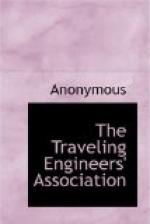A. This will cause a loss of main reservoir air, and both ends of the pipe must be plugged. As no air now comes to the feed valve to charge the brake pipe in running or holding position of the brake valve, the handle must be carried in release position.
107. Q. What must be done if the pipe between the feed valve and automatic brake valve breaks?
A. Slack off on the regulating nut of the feed valve until all tension is removed from the regulating spring and plug the pipe toward the brake valve. To charge the brake pipe, the brake valve handle must be carried in release position.
108. Q. If the feed valve becomes defective so that it will not control brake pipe pressure, what may be done?
A. As the reducing valve used for the independent brake, and the feed valve are practically the same, they may be changed one for the other, the reducing valve taking the place of the feed valve.
INDEPENDENT BRAKE VALVE
109. Q. Name the different positions of the independent brake valve used with the E-T equipment.
A. Release, running, lap, slow-application position, quick-application position.
110. Q. What is the purpose of release position?
A. To release the locomotive brake when the automatic brake valve is in other than running position.
111. Q. What is the purpose of running position?
A. This is the proper position for the brake valve when not in use, and to release the locomotive brake when the automatic brake valve is in running position.
112. Q. What is the purpose of lap position?
A. To hold the locomotive brake applied after an independent application.
113. Q. What is the purpose of slow-application position?
A. This position may be used when it is desired to make a light or gradual application of the brake, as in stretching or bunching the slack of a train.
114. Q. What is the purpose of quick-application position?
A. To apply the locomotive brake quickly, as in short switching.
115. Q. What brake cylinder pressure is usually developed with this brake?
A. About forty-five pounds.
DEAD ENGINE FEATURE
116. Q. What is the dead engine device?
A. The dead engine device is a pipe connection between the main reservoir and the brake pipe. In this pipe is found a combined strainer and check valve with a choke fitting and cut-out cock, which when open forms a connection between the brake pipe and the main reservoir.
117. Q. What is the purpose of this device?
A. To provide a means of charging the main reservoir of an engine whose compressor is inoperative.
118. Q. What is the object of charging a main reservoir of an engine with a disabled compressor?




